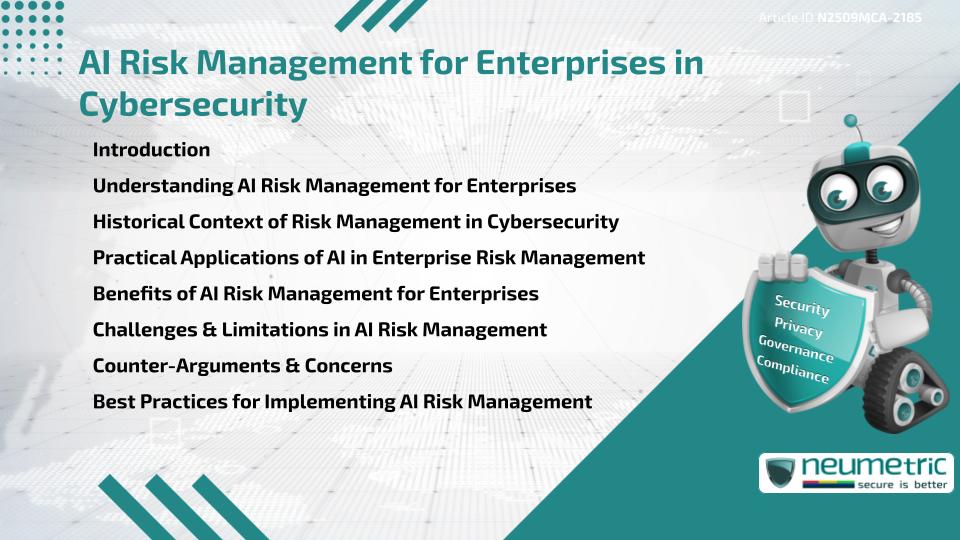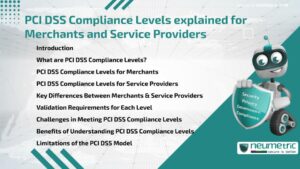Table of Contents
ToggleIntroduction
Artificial Intelligence [AI] is reshaping how businesses defend themselves against Digital Threats. AI Risk Management for enterprises is a structured approach that helps Organisations identify, assess & mitigate Risks linked with using AI in Cybersecurity. This practice enables companies to protect Sensitive Data, maintain Compliance & avoid costly Breaches. By combining historical lessons from traditional Risk Management with modern AI-powered tools, enterprises can achieve stronger defenses. However, AI introduces new Risks such as bias, automation errors & lack of transparency. This article explores how AI Risk Management for enterprises strengthens Cybersecurity, its challenges & practical strategies for effective implementation.
Understanding AI Risk Management for Enterprises
AI Risk Management for enterprises involves analysing Risks introduced by AI Systems while also using AI to enhance security operations. For instance, AI algorithms can detect anomalies in network traffic faster than humans, but they may also produce false positives or overlook novel attack patterns. Balancing these Strengths & Risks forms the core of enterprise-level AI Risk Management.
Historical Context of Risk Management in Cybersecurity
Risk Management has long been central to Cybersecurity. In the early days, businesses focused on Firewalls, Antivirus software & manual Audits. Over time, methods evolved to include automated Monitoring & Compliance frameworks. AI Risk Management for enterprises represents the next stage in this evolution. It builds upon decades of practices, integrating Machine Learning & Predictive Analytics to anticipate Threats rather than simply react to them.
Practical Applications of AI in Enterprise Risk Management
AI is widely used in enterprise Cybersecurity through:
- Threat Detection: AI scans large data volumes for unusual patterns.
- Fraud Prevention: AI Models flag suspicious Financial activity.
- Compliance Monitoring: Automated systems ensure adherence to standards.
- Incident Response: AI assists in prioritising alerts & suggesting remediation steps.
For example, AI-powered platforms can recognise phishing attempts by analysing email structures & User behavior. This proactive protection reduces the burden on human teams.
Benefits of AI Risk Management for Enterprises
The advantages of AI Risk Management for enterprises include:
- Faster detection & response to Cyber Incidents.
- Reduced human error through automated processes.
- Cost efficiency by minimising downtime from attacks.
- Improved Compliance with Industry Regulations.
- Enhanced adaptability to evolving Threats.
Enterprises can compare AI’s role in Cybersecurity to an immune system: it learns, adapts & responds more effectively with each exposure to Threats.
Challenges & Limitations in AI Risk Management
Despite its strengths, AI brings new Risks. Algorithms may be biased if trained on poor-quality data. Overreliance on AI can also create blind spots, as attackers may exploit system weaknesses. Another limitation is the lack of transparency in how AI makes decisions, sometimes referred to as the “Black Box” problem. Additionally, implementing AI tools requires significant Financial & technical investment, which not all enterprises can afford.
Counter-Arguments & Concerns
Some critics argue that AI Risk Management for enterprises can create a false sense of security. While AI automates many tasks, it cannot replace human judgment in all cases. Cybercriminals are also leveraging AI for attacks, leading to an arms race between defenders & attackers. This raises concerns about whether enterprises may unintentionally escalate Risks by depending too heavily on AI technologies.
Best Practices for Implementing AI Risk Management
To maximise benefits & minimise Risks, enterprises should:
- Use diverse, high-quality datasets to train AI Models.
- Combine AI tools with human oversight.
- Regularly Audit & update AI Systems.
- Maintain transparency by documenting how AI Systems make decisions.
- Establish Incident Response plans that integrate AI insights.
Conclusion
AI Risk Management for enterprises is not just about adopting new technologies, but about creating balanced frameworks that address both opportunities & challenges. By applying historical lessons, ensuring transparency & integrating human oversight, enterprises can strengthen Cybersecurity resilience.
Takeaways
- AI Risk Management for enterprises balances strengths & Risks of AI Systems.
- Historical Risk Management practices laid the foundation for AI-driven methods.
- Benefits include faster Detection, reduced Costs & improved Compliance.
- Challenges include bias, lack of transparency & overreliance on automation.
- Best Practices combine high-quality data, human oversight & regular Audits.
FAQ
What is AI Risk Management for enterprises?
It is a structured approach that helps businesses assess & mitigate Risks introduced by using AI in Cybersecurity while leveraging AI to enhance security.
How does AI improve enterprise Cybersecurity?
AI improves enterprise Cybersecurity by detecting Threats faster, reducing human error & providing adaptive defenses against evolving attacks.
What are the Risks of using AI in enterprise Cybersecurity?
The Risks include algorithmic bias, overreliance on automation, high costs & lack of transparency in decision-making.
Can AI fully replace humans in Cybersecurity?
No, AI cannot fully replace humans. Human oversight is essential for interpreting AI outputs, handling exceptions & making critical decisions.
Why is transparency important in AI Risk Management?
Transparency ensures enterprises understand how AI Systems reach decisions, reducing blind spots & building trust with Stakeholders.
How can enterprises implement AI Risk Management effectively?
They can implement it by using quality datasets, combining AI with human oversight, conducting Audits & following recognised Guidelines.
Are cybercriminals also using AI?
Yes, attackers increasingly use AI for tasks like creating sophisticated phishing campaigns or evading detection, which raises the stakes for enterprises.
Need help for Security, Privacy, Governance & VAPT?
Neumetric provides organisations the necessary help to achieve their Cybersecurity, Compliance, Governance, Privacy, Certifications & Pentesting needs.
Organisations & Businesses, specifically those which provide SaaS & AI Solutions in the Fintech, BFSI & other regulated sectors, usually need a Cybersecurity Partner for meeting & maintaining the ongoing Security & Privacy needs & requirements of their Enterprise Clients & Privacy conscious Customers.
SOC 2, ISO 27001, ISO 42001, NIST, HIPAA, HECVAT, EU GDPR are some of the Frameworks that are served by Fusion – a SaaS, multimodular, multitenant, centralised, automated, Cybersecurity & Compliance Management system.
Neumetric also provides Expert Services for technical security which covers VAPT for Web Applications, APIs, iOS & Android Mobile Apps, Security Testing for AWS & other Cloud Environments & Cloud Infrastructure & other similar scopes.
Reach out to us by Email or filling out the Contact Form…





